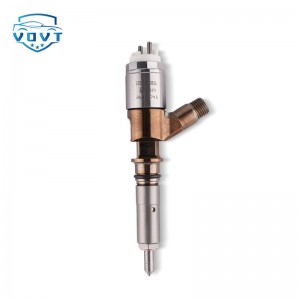New High Quality Diesel Injector 9Y-1785 9Y-4544 111-3718 10R-3053 6I-4355 0R-8338 For CAT 3500A
Products Description
| Reference. Codes | 3500A |
| Application | 3500A |
| MOQ | 4PCS |
| Certification | ISO9001 |
| Place of Origin | China |
| Packaging | Neutral packing |
| Quality Control | 100% tested before shipment |
| Lead time | 7~10 working days |
| Payment | T/T, L/C, Paypal, Western Union, MoneyGram or as your requirement |
What are the common faults of the solenoid valve in the injector pressure control mechanism?
The solenoid valve in the injector pressure control mechanism is a precision component, and its failure will directly affect the accuracy of fuel injection and engine performance. The following are common types of solenoid valve failures, causes and effects:
1. Solenoid valve stuck or blocked
Fault manifestation
The solenoid valve core (or armature) is stuck due to impurities, oil or rust, resulting in failure to switch normally.
The injector sprays fuel abnormally (such as continuous dripping or failure to open), and the engine has unstable idle speed, increased fuel consumption or excessive emissions.
Main causes
Fuel contamination: The fuel contains impurities (such as metal debris, colloid) or water, which are deposited in the valve core gap or sealing surface after long-term use.
Insufficient lubrication: The fuel has poor lubricity, resulting in wear or rust on the valve core and valve seat.
High temperature aging: The high temperature environment in the engine compartment causes the internal rubber parts of the solenoid valve (such as the sealing ring) to age and deform, and debris enters the valve core gap.
Impact
Stuck in the open state: Continuous fuel leakage may cause difficulty in starting the engine or flameout.
Stuck in the closed state: fuel cannot be injected, the corresponding cylinder does not work, the engine power decreases or the cylinder is missing.
2. Solenoid coil failure
Fault manifestation
The coil is short-circuited, open-circuited or the resistance value is abnormal, and the solenoid valve cannot respond to the ECU signal.
The engine fault light is on, and there is weak acceleration, idle jitter or failure to start.
Main cause
Coil aging: The insulation layer ages and breaks under long-term high temperature, causing the coil to short-circuit or open-circuit.
Current shock: ECU signal abnormalities (such as voltage fluctuations) or poor line contact cause the coil to overheat and burn.
Mechanical damage: Vibration or improper installation causes the coil lead to break or the connector to loosen.
Impact
Coil open circuit: The solenoid valve fails completely and cannot execute the injection command.
Coil short circuit: The ECU drive circuit may be burned, causing more serious electrical failures.
3. Decreased sealing performance
Fault manifestation
The solenoid valve seals (such as O-rings and valve seat sealing surfaces) are worn or aged, causing fuel leakage.
Fuel odor appears in the engine compartment, which may be accompanied by unstable idle speed or difficulty in starting.
Main reasons
Wear and aging: Frequent switching causes wear of the sealing surface, or hardening and cracking of rubber seals.
Corrosion damage: Acidic substances or moisture in the fuel corrode the sealing material.
Improper installation: Seals are misaligned or over-extended during installation, causing permanent deformation.
Impact
Internal leakage: leads to insufficient injection pressure, reduced injection volume, and reduced engine power.
External leakage: There is a risk of fuel leakage, which may cause fire hazards.
4. Delayed response or failure
Fault manifestation
The solenoid valve responds slowly to the ECU signal, or cannot complete the opening/closing action within the specified time.
The power lags when the engine accelerates, or the injection timing is inaccurate, resulting in excessive emissions.
Main reasons
Wear of mechanical parts: The clearance between the valve core, armature and spring is too large, and the movement resistance increases.
Electromagnetic performance degradation: The coil is demagnetized or the spring elasticity decreases, resulting in a slower valve core movement speed.
Abnormal signal transmission: poor line contact, oxidation of connectors or distortion of ECU output signals.
Impact
Deviation in injection timing: early injection may cause knocking, and delayed injection may cause incomplete combustion.
Inaccurate injection quantity control: affects the air-fuel ratio and causes engine performance to deteriorate.
V. Other common problems
Foreign matter stuck: foreign matter such as metal chips and dust left during assembly enters the solenoid valve and interferes with the movement of the valve core.
Voltage matching problem: after using non-original accessories or circuit modification, the working voltage of the solenoid valve does not match the ECU output, resulting in malfunction.
Environmental factors: high humidity environment causes the coil to short-circuit due to moisture, or the viscosity of fuel increases at low temperatures, increasing the resistance of the valve core movement.
Troubleshooting and maintenance suggestions
Regular fuel cleaning: use high-quality fuel and add fuel cleaner regularly to reduce impurity deposition.
Standardized maintenance process: avoid bumping when disassembling the solenoid valve, check the status of the seal before installation, and ensure that it is installed in place.
Circuit detection: regularly check the line connection and measure whether the coil resistance meets the original factory standard.
Replace accessories in time: If the solenoid valve performance is found to be degraded (such as delayed response), it is recommended to replace the original accessories to avoid the expansion of the fault.
By specifically troubleshooting the mechanical, electrical and sealing problems of the solenoid valve, the reliability of the injector pressure control can be effectively improved to ensure the efficient and stable operation of the engine.






















